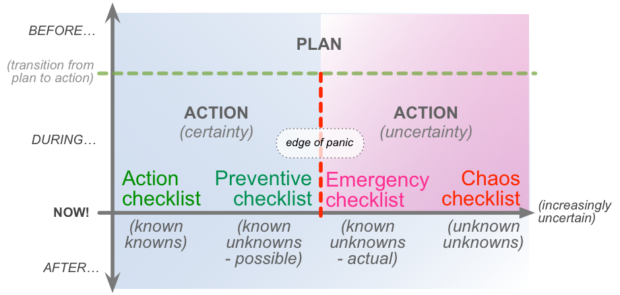The fourth checklist
There are four types of checklist. We need all of them in place before any work starts.
The first type of checklist is the action-checklist – the work-instruction. It’s a list of tasks, in sequence, step by step, for use with the ‘known-knowns’, when we certain that the world of that task is certain. It’s perhaps not so much a checklist as a literal ‘tick the box’ exercise: do a task, put a check-mark in the box, do a task, put a check-mark in the box, do a task… Everyone knows about this type of checklist: they’re everywhere. Even for tasks where they’re not appropriate at all.
The second type of checklist is the preventive-checklist – the type that most people would describe as ‘a checklist’. It’s a list of tests or checks, not necessarily in strict step-by-step order, that we’d use when things are somewhat less certain, and we want to prevent certain ‘known-unknowns’ from happening. Check the oil; check the tyres; check the coolant-level; check that there’s enough fuel in the tank: that kind of thing. It’s uncertain until we check it, so check first, than we can be a bit more certain that it’s certain.
The third type of checklist is the emergency-checklist. This is the type of checklist that we’d use when it’s no longer that certain ‘known-unknowns’ could go wrong, they have gone wrong, and we’re now crossed over to the far side of the ‘edge of panic’. It’s a list of checks and actions that can help to recover from an active ‘known-unknown’ – particularly about useful things that people otherwise tend to forget when they’re over on the far side of the ‘edge of panic’. Most people know about this type of checklist, too – though it’s one they’d hope they never have to use.
But the fourth type of checklist is so little known-about, so little understood, that it doesn’t even have a well-known name. Perhaps call it the chaos-checklist, because it’s when things have gone into chaos, that it most comes into its own. It’s the checklist that, when we hit up against a cloud of ‘unknown-unknowns’, way over beyond the far side of the ‘edge of panic’, often gives the only way to make sense of what’s going on, and what we can usefully do. It’s the type of checklist that people most often don’t know about – yet often also the one they need the most, when the world goes wildly uncertain, and need some form of guidance to suggest what to do next.
Unlike the other checklists, which tend to be concrete, specific, explicit, this fourth checklist is made up of a set of more abstract themes: vision, values, principles, that kind of thing. They might at first seem like little more than platitudes, wishful-thinking – but they actually work as seeds or anchors around which some form of meaning can coalesce, and decisions can be made. This is one of the reasons why visioning is so important in enterprise-architecture and the like – because it’s from there that we derive the content for this fourth checklist.
So, four types of checklist, to help us deal with different levels of uncertainty, different mixes of known and unknown. Yet in each case, we need all four types of checklist to be in place before we start the action. When we’re in the action, we don’t have time to stop and go back to write the checklist that we need – especially so when things have gone uncertain on us, and we have no other clear guidance as to what to do. We may place all of the work at risk if we miss out any of these checklists from our preparation for the work.

Hi Tom, have you seen the Cynefin framework? It gives yet another perspective, and IMHO a good lens for architecture work.
Many thanks, Jos. Short-answer to “Have you seen Cynefin”: Yes, I have. Unfortunately. See http://weblog.tetradian.com/tag/cynefin/
Best leave it at that?